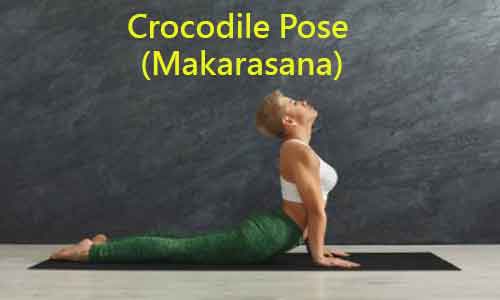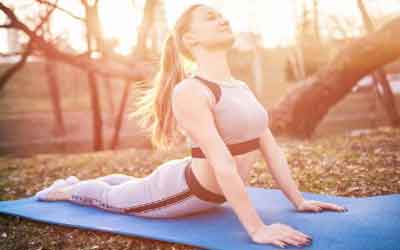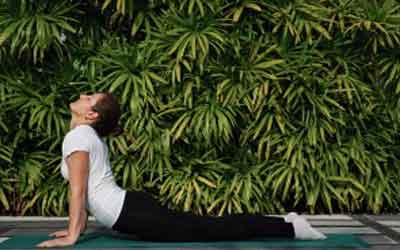What is the Crocodile pose (Makarasana)?
Crocodile Pose (Makarasana) is a starter yoga pose that comforts the whole body and helps relieve pain related to other yoga poses or other activities. By lying flat facing your stomach downwards with your chest and shoulders resting, you waive-off tension in the lower back and open up your chest and shoulders. This pose is an excellent way to relieve stress. In this article we will explore What is Crocodile Pose, its benefits and how to practice Crocodile Pose?

What is the Crocodile pose (Makarasana)
This yoga pose can be a concluding pose to end your session or sequence. This pose helps to wrap up all the tension and fatigue that arise while practicing other yoga exercises or kriyas. All you need to get started is a floor mat, uneven ground, or floor to practice.
Meaning of Makarasana (Crocodile pose)
The word Makarasana is inspired by Sanskrit, basically called Crocodile pose in English. Makarasana (Crocodile pose) is a gentle and remedial yoga posture usually practiced after all other yogic kriyas or exercises. The name of the pose comes from the Sanskrit words “Makara,” meaning “Crocodile,” and “asana,” meaning pose.”
According to Hindu mythology, the posture is titled after the Crocodile because it resembles this aquatic animal’s quiet, calm, and restful position. Makarasana is predominantly an excellent pose to relax the whole body and mind.
Origin of Crocodile Pose (Makarasana)
The crocodile pose (Makarasana) is thousands of years old, mentioned in ancient yoga textbooks and their practices. The pose has its narrative in Gheranda Samhita 17th century (Gheranda Samhita is one of the three primary classical texts of Hatha yoga, which features different yogic kriyas or practices).
The pose was again retold in Halftone in the book Yogasopana Purvacatuska in 1905 (Yogasopana Purvacatuska is also an old text on Hatha yoga describing 37 different postures of yoga).In classical times the holy saints used to eye reptiles, studying nature to develop new yoga postures with numerous benefits.

what is makarasana
Yogic Explanation of Crocodile Pose (Makarasana)
From a yogic point of view, the Crocodile pose (Makarasana) symbolizes calmness and peacefulness. In this state of relaxation and deep breathing, the posture is said to activate and balance the Vishuddha chakra (Vishuddha chakra is found in the throat and is responsible for communication and self-expressivity). The balance of the Vishuddha chakra promotes clarity of speech and a sense of reliability and correctness.
Another spiritual benefit of practicing the pose involves opening Svadisthana or Sacral chakra (Svadisthana chakra is responsible for creativity and sexual energy). Crocodile pose (Makarasana) also helps the uniform flow of blood throughout the body, stimulating the body’s digestive and other major organs, resulting in an overall improvement in every part of the human body.
How to Practice Crocodile Pose (Makarasana)?
The pose is one of the simple poses in modern yoga exercises. Here are some significant steps to follow
1. First, choose a flat ground or floor and a soft yoga mat to practice.
2. Lie flat on the ground, facing your stomach downwards, your feet should be hip-width apart, and your toes should be pointed front-forward.
3. Rest your elbows and your hands on the ground by your side, and your hands should be clamped to each other, resting over your head.
4. Gently start breathing and inflate your lungs completely.
5. Let your body relax with your eyes fully shut.
6. Slowly start exhaling and ease your legs, feet, and hands.
7. Now relax your upper and lower back, including your groin area, as if there is no tension.
8. Now steadily, in small doses, discharge any tension over your body and mind.
9. Stay calm. Take a deep breath and slowly release the air from your lungs.
10. Now without any body movements, draw your complete attention and observe your respiratory activity.
11. Avoid napping or falling asleep, and continue the pose for another 10-15 minutes.
12. Release the pose, slowly turn to your right side and retain your normal position.

what is crocodile pose
Additional tips while practicing Crocodile pose (Makarasana)
Here are some other tips that might prove helpful while practicing the pose.
- Correct posture- The critical part of practicing the pose is keeping the correct posture and body alignment to get better results and avoid getting injured.
- Release pressure or tension – The principle and most essential to the healthy practice of this pose is to relax and release any pressure over the body and your mind. Staying calm and neutral thought process will find better results for you.
- Breathing movements – Mind to concentrate upon steady breathing movements. Do not burn your energy while deeply inhaling and exhaling.
- Target shorter intervals initially – While practicing the pose at a beginner’s level, try to stay in the pose for shorter periods for about 5-10 min or as per your comfort level. Aim for a longer duration only when you are experienced enough to practice.
Benefits of Crocodile Pose (Makarasana)
This is one of the excellent poses practiced at the end of all yoga sessions. It has numerous benefits to the human body if practiced correctly. Here are some significant benefits of the pose:
- Relieve stress: The Crocodile pose (Makarasana) helps ease and eradicate the stress and tension in the body. It stables and aids to comfort the mind.
- Improves posture: This pose is an excellent method to correct the posture and alignment of the body. Practicing for a longer duration daily eradicates any unsteadiness issues you face while walking.
- Strengthens Core Muscles: Crocodile pose (Makarasana) helps strengthen core muscles, including the abs and lower back.
- Reduce back inflammation: This pose stretches the spine and strengthens the muscles. It is very much valuable for reducing back pain or inflammation.
- Improves Digestion:This pose helps stimulate the digestive system and other significant organs, promoting healthy bowel movements and working with other major organs like the pancreas, spleen, kidneys, intestine, etc.
- Reduces anxiety: The pose helps to reduce stress and promotes a feeling of calmness and relaxation.
- Improves lung function: Crocodile pose (Makarasana) helps improve lung function by stretching the chest and deep inhaling during practice.
- Improves Blood Circulation: This pose helps improve blood flow uniformly throughout the body, promoting an overall healthy body and vitality.
- Reduces Fatigue: Crocodile pose promotes relaxation and calmness through the body and mind, reducing fatigue and boosting energy levels.
- Increases flexibility and improves concentration: While practicing the pose, the whole body is stretched, which increases flexibility, and the relaxing process enhances focus and mental clarity.
Injuries and helpful tips to avoid injuries
Like every other yogic kriyas or exercise, the Crocodile pose is also likely to risk injuries if not practiced correctly. Following are some injuries related to the posture and helpful tips to avoid them
- Neck strain- While practicing the pose, keeping the neck in the neutral position or the position described by the instructor is mandatory. Frequently turning your neck could lead to a neck injury or strain. Always keep your neck steady.
- Back injury- Remember to practice on a flat ground or floor while practicing the pose. Uneven ground or floor could lead to a severe back injury.
- Collar bone or shoulder sprain- While practicing the pose, the shoulders or collar bone should be steadily in the resting or desired position; otherwise, it could lead to a sprain or injury. The back and shoulders should be at ease while in the pose.
- Knee Injury- If you have any discomfort or inflammatory issue with the knee, try to modify the pose under supervision; otherwise, it could worsen the situation.
Contraindications and limitations of Crocodile pose (Makarasana)
This is a secured and unharmed pose in modern yoga exercises. But every posture is prone to some restrictions to practice under. Here are some significant contraindications discussed
- Pregnant Women:Pregnant women should avoid the pose in 3rd month of pregnancy for a longer duration without any medical advice and supervision. It could damage the developing foetus or damage the amniotic bag.
- Past abdominal surgery:Avoiding the pose if you have undergone any surgery over the abdomen is highly advised. It is also recommended to seek medical advice before practicing the pose.
- Low or high blood pressure:People with abnormal blood pressure levels should always avoid lying flat on the floor or ground practicing the pose. Practicing posture over the abdomen could raise or lower blood pressure levels.
- Asthmatic patients: People with respiratory disorders should avoid the pose as it could lead to discomfort in breathing. Patients with respiratory dysfunction should perform under supervision.
Final Words
Crocodile pose (Makarasana) is a user-friendly pose practiced at the end of all yogic kriyas or exercises to ease or release the pressure or strain caused while practicing other exercises. The pose is a symbol of peace and calmness.
The posture has been practiced for thousands of years and resembles the aquatic animal Crocodile in the resting pose. Like other yoga postures, it has numerous benefits. It is the only pose that targets almost every part of the human body, promoting a healthy, disease-free body.
FAQ’s about What is the Crocodile Pose (Makarasana)
(Q-1) Is the Crocodile pose (Makarasana) meant for some particular level, or can beginners also practice?
(A) Crocodile pose (Makarasana) is user-friendly and can be practiced at all age groups. This pose is among the safest poses of all other yoga poses or exercises.
(Q-2) How long should the pose be held while practicing the pose?
(A) A beginner should start with 5-10 minutes to hold the pose. Aim for a longer duration as you gain some experience.
(Q-3) Is it safe to practice Crocodile pose (Makarasana) in the evening after having a meal?
(A) Crocodile pose (Makarasana) is a safe pose to practice at any time in the 24 hours, but preferably, the most favorable timings are in the morning with an empty stomach.
(Q-4) Is practicing the Crocodile pose (Makarasana) for plus-size people with belly fat safe?
(A) Crocodile pose (Makarasana) can be practiced by anyone regardless of size or belly fat. Aim to practice with shorter intervals, and slowly increasing the duration is highly recommended. If the pose is practiced by such people at regular intervals daily, it could even result in losing weight.
(Q-5) Can Crocodile pose (Makarasana) be practiced by people suffering from seizures or epilepsy?
(A) Crocodile pose (Makarasana) is one of the safest poses among all modern yoga exercises, but seeking medical advice before starting a practice is highly recommended.
Read more articles
What is Garland pose (Malasana)?
What is a Chair pose (Utkatasana)?
Join Our Facebook Page
Author
Bhavika Panesar



